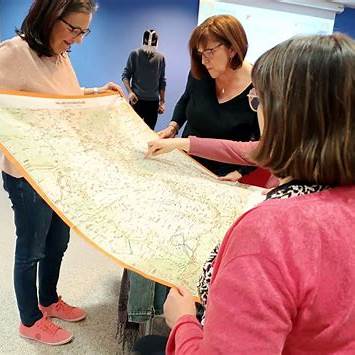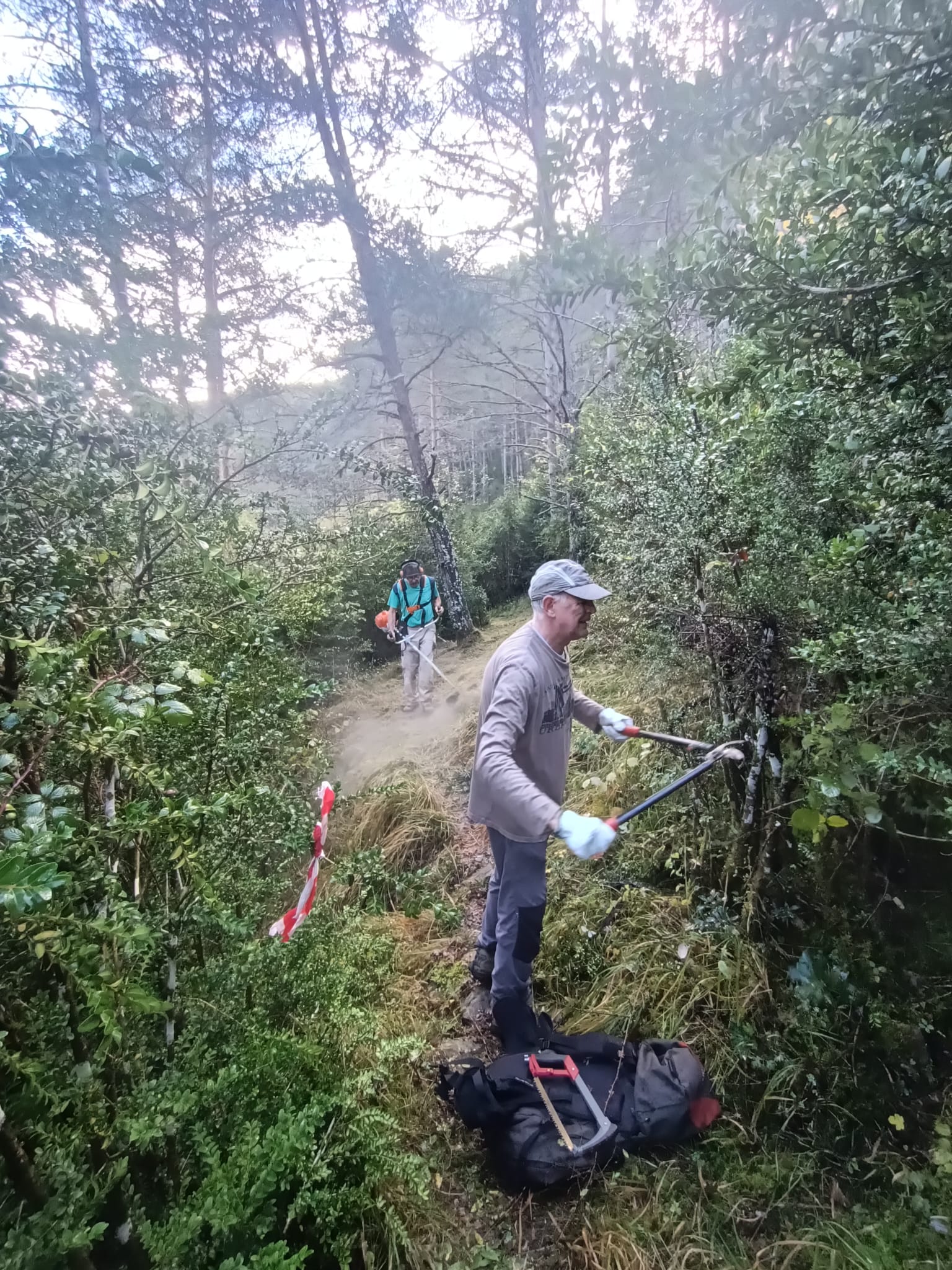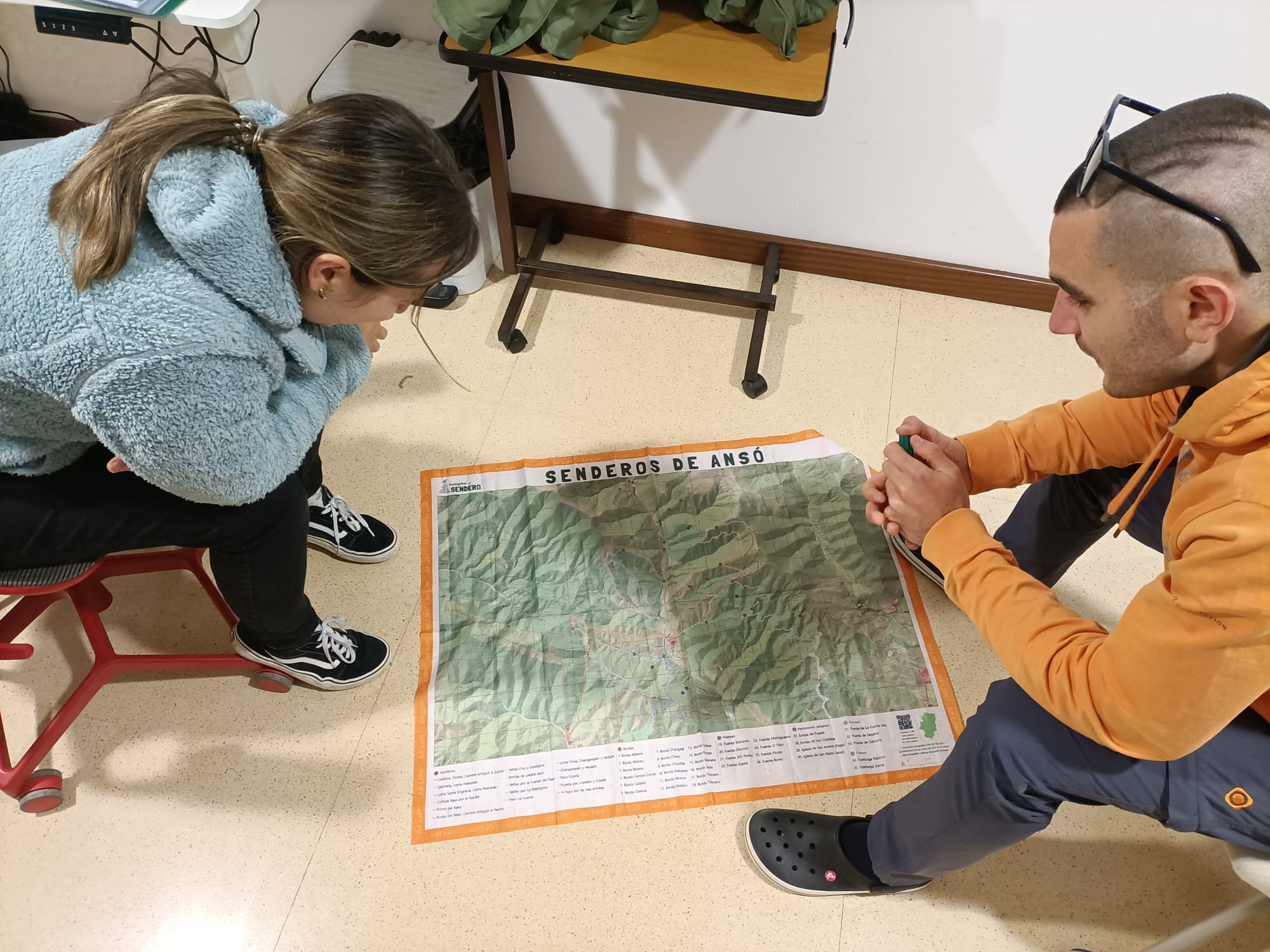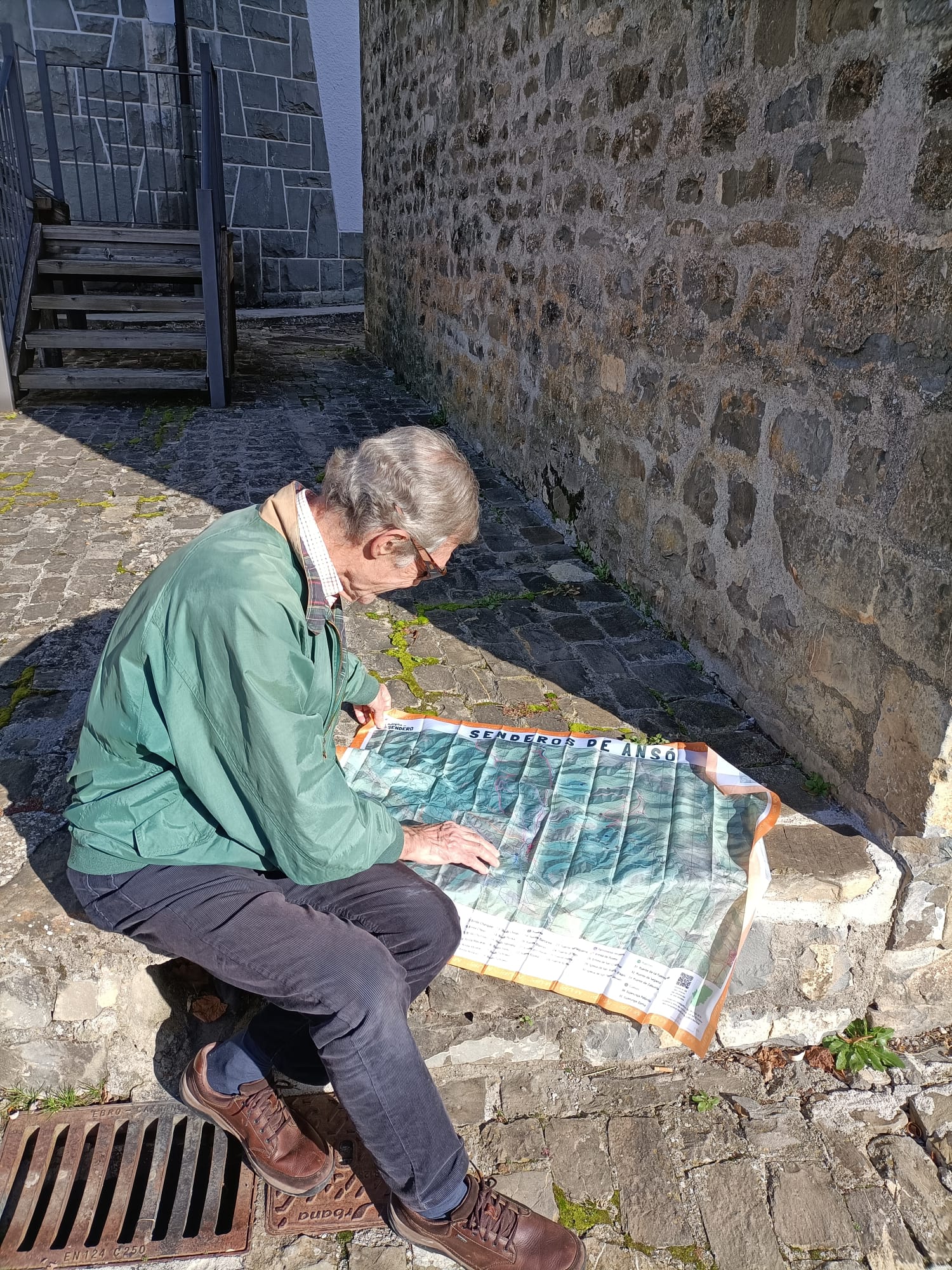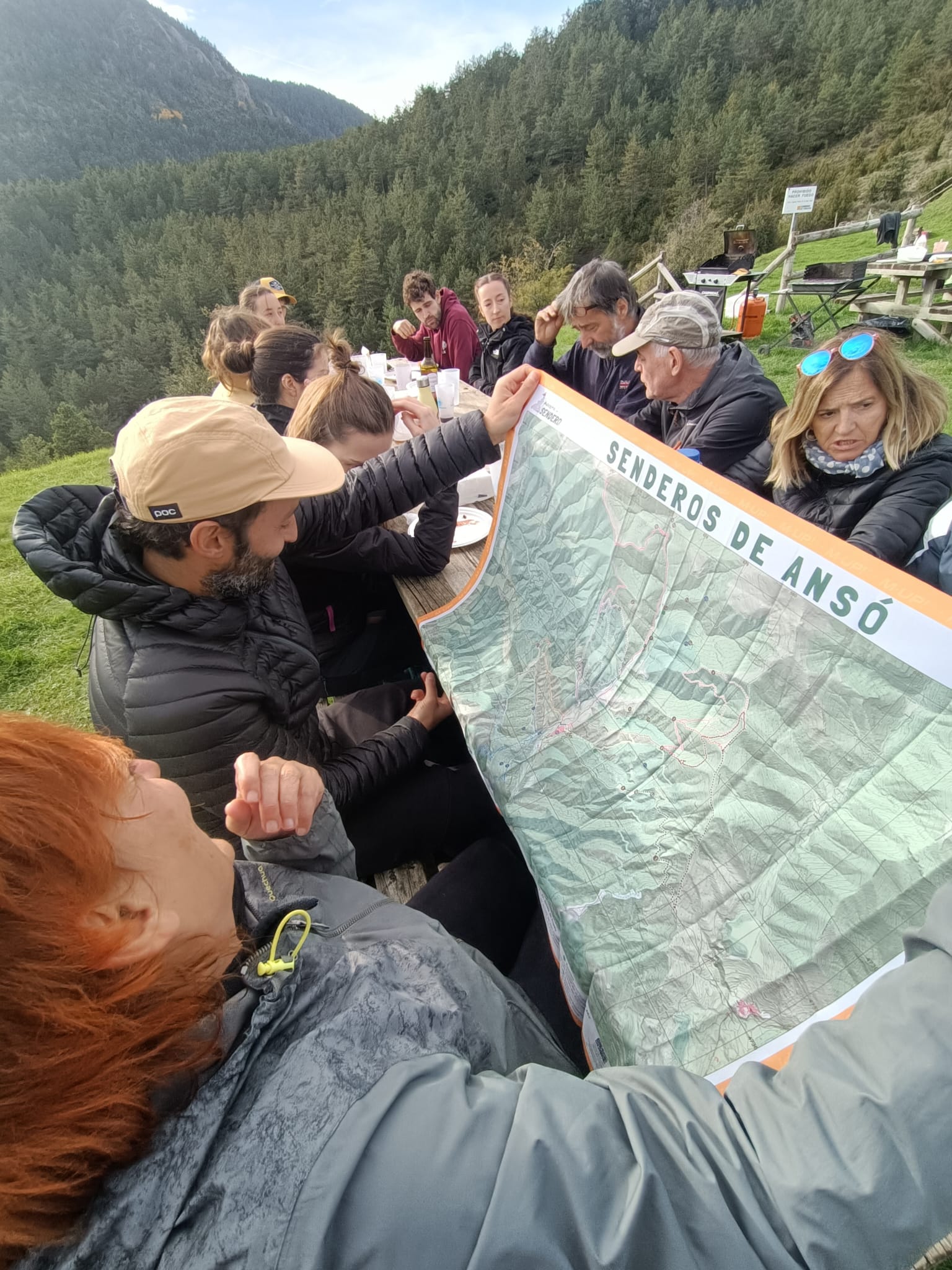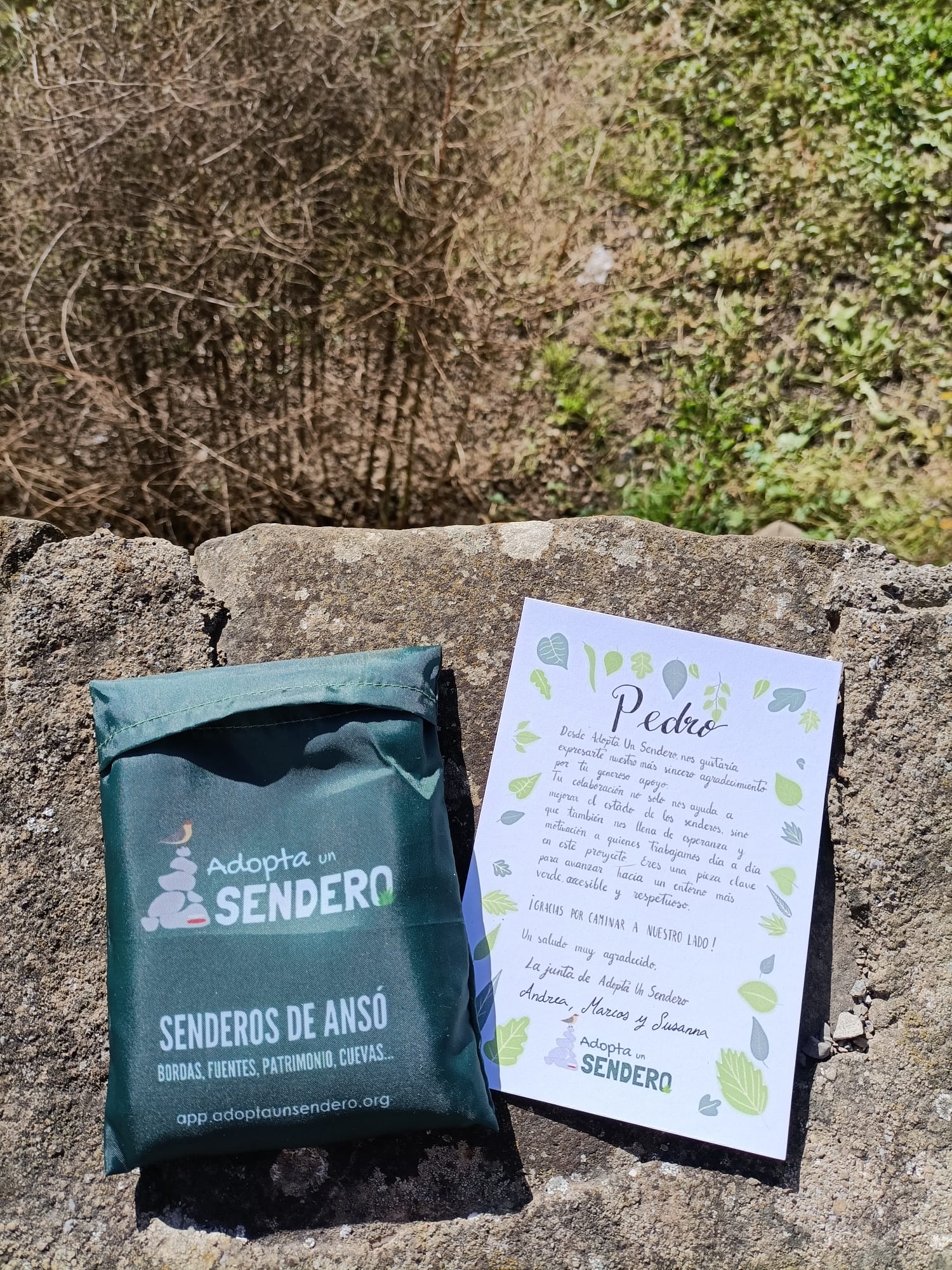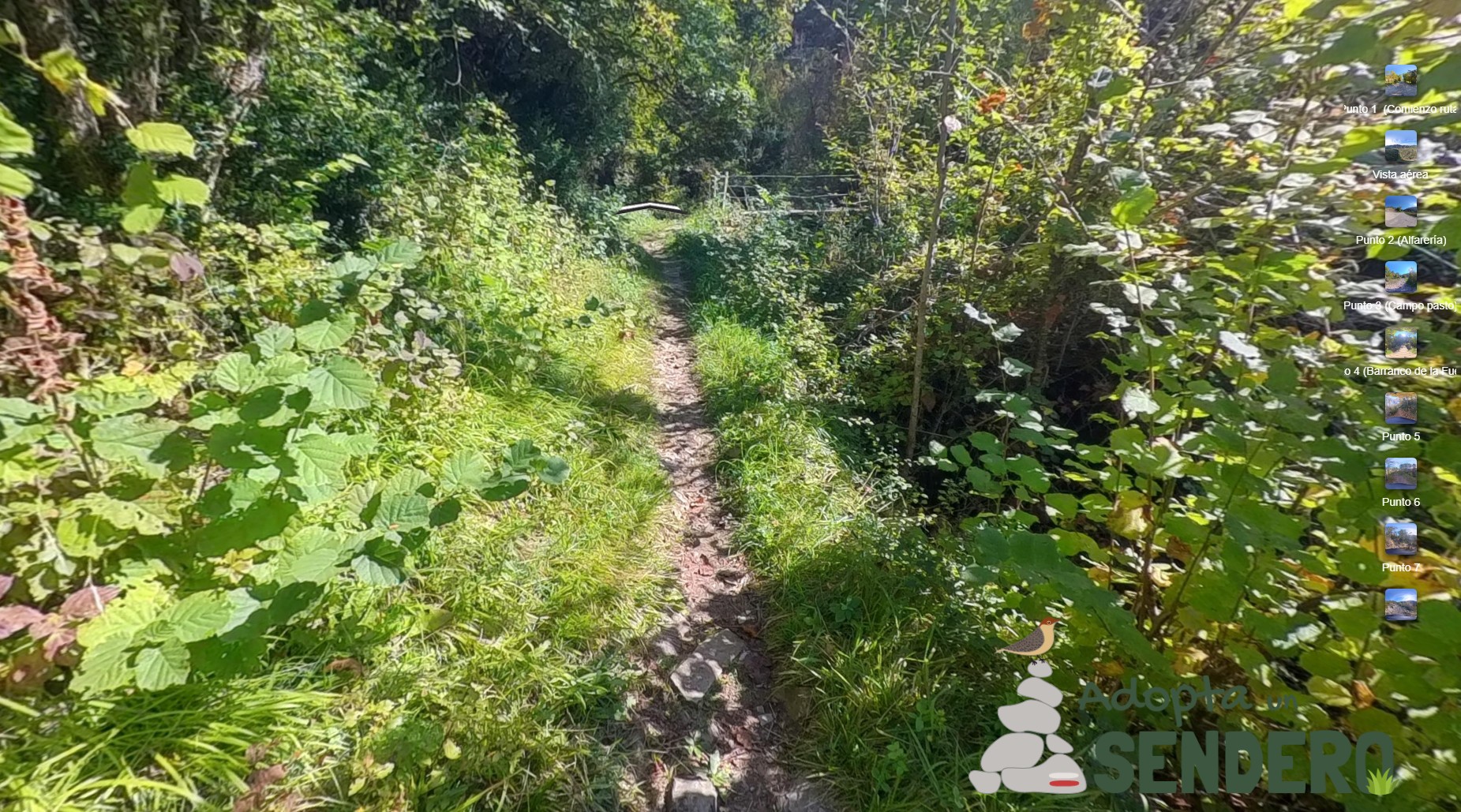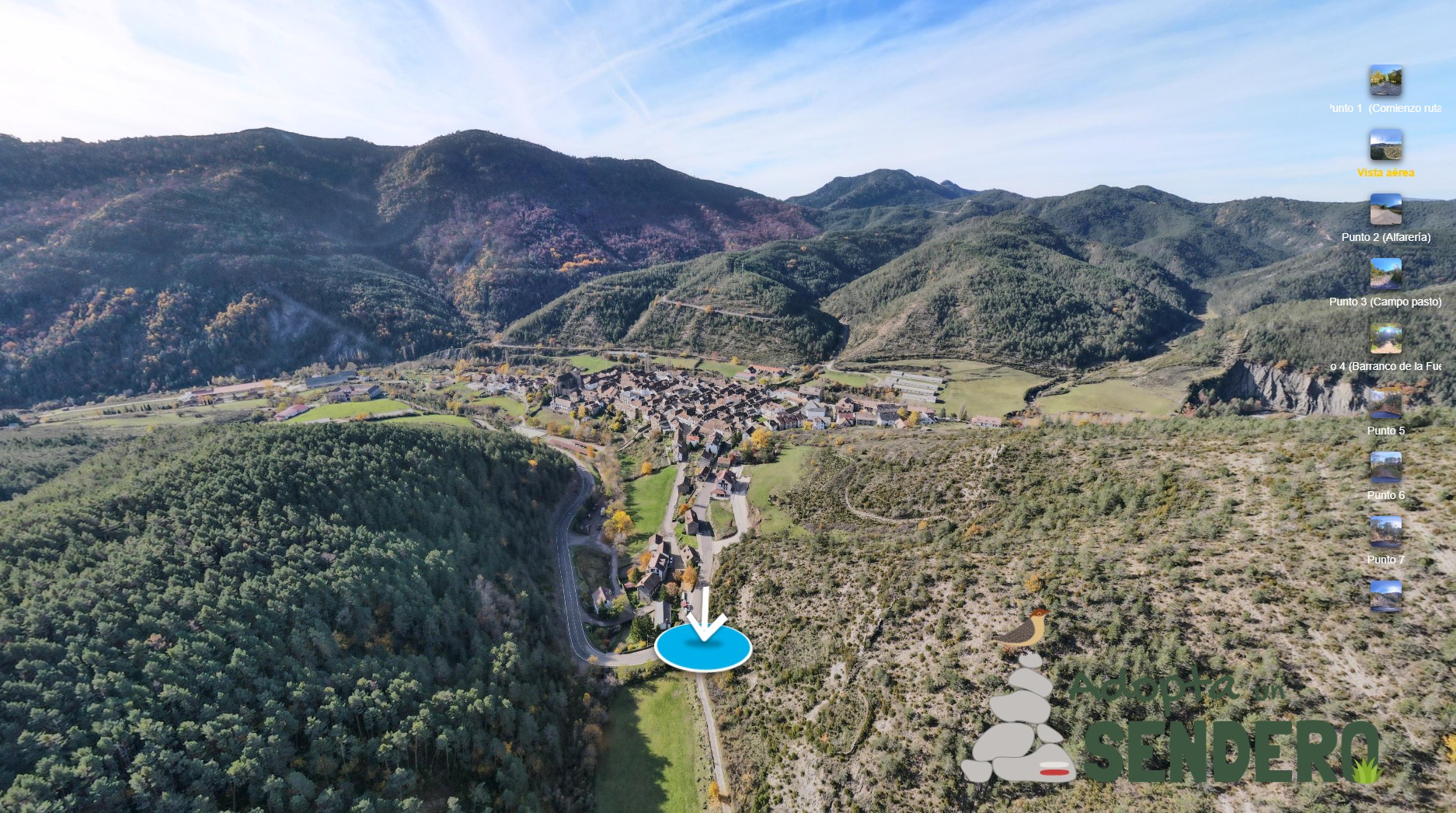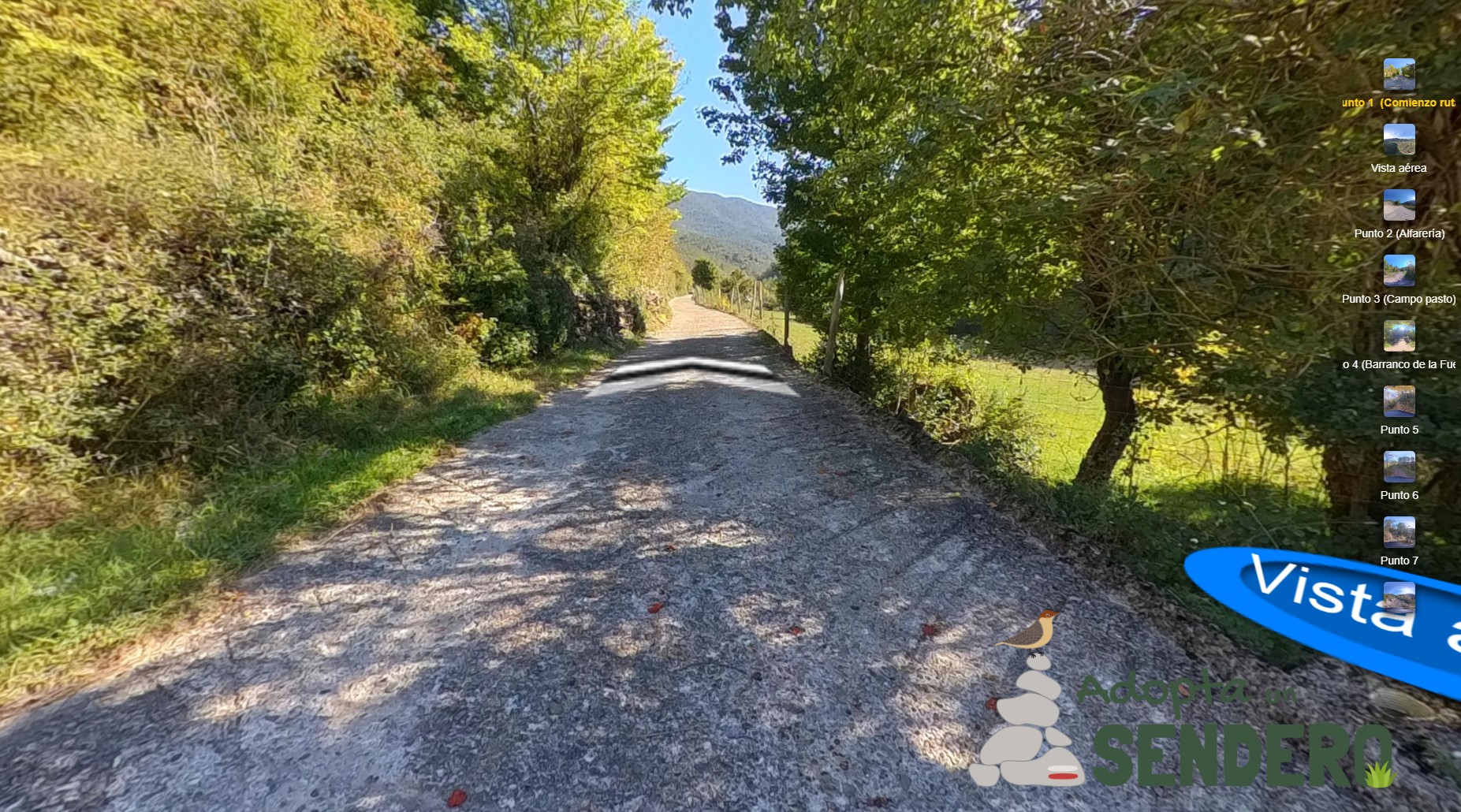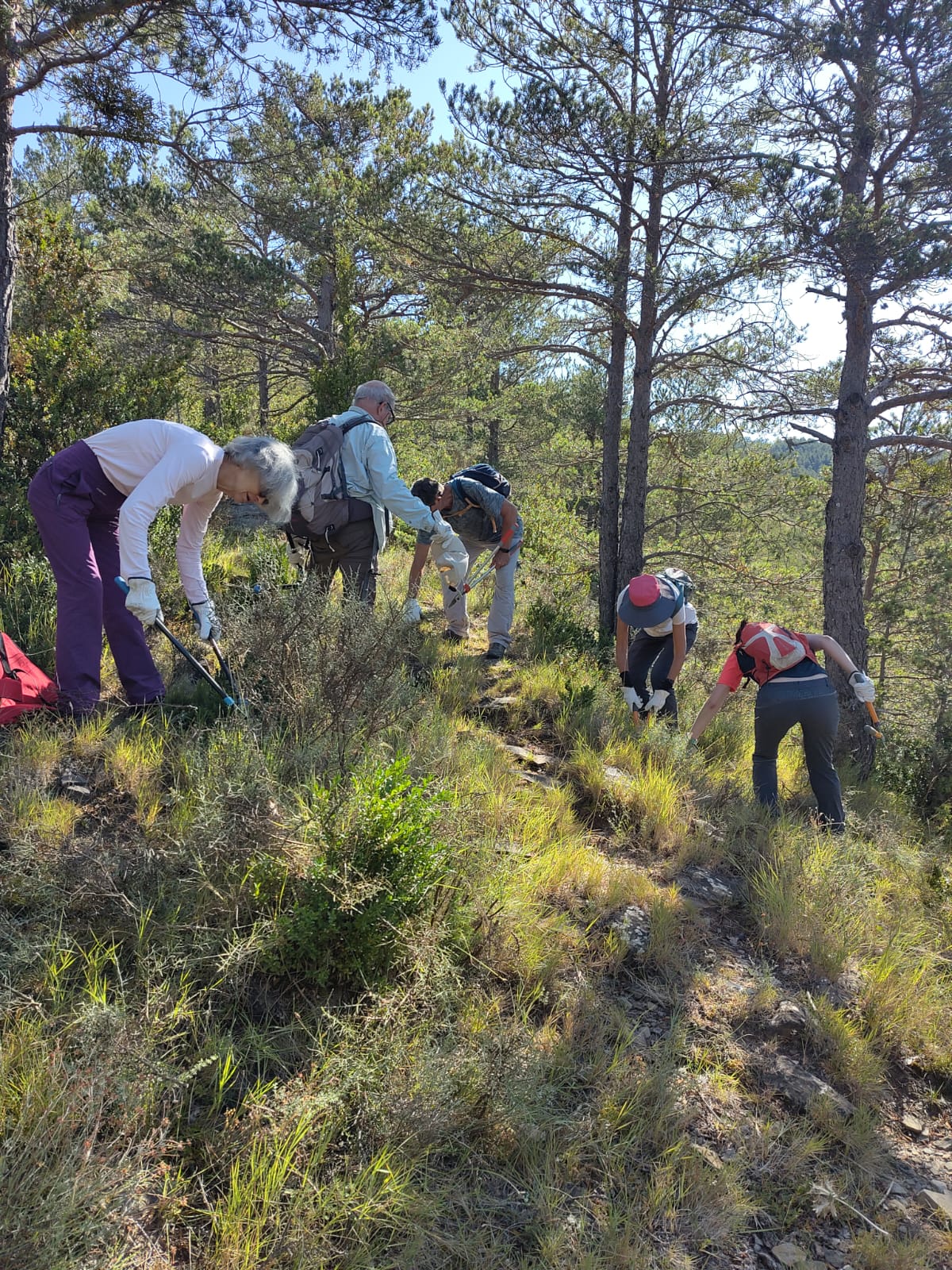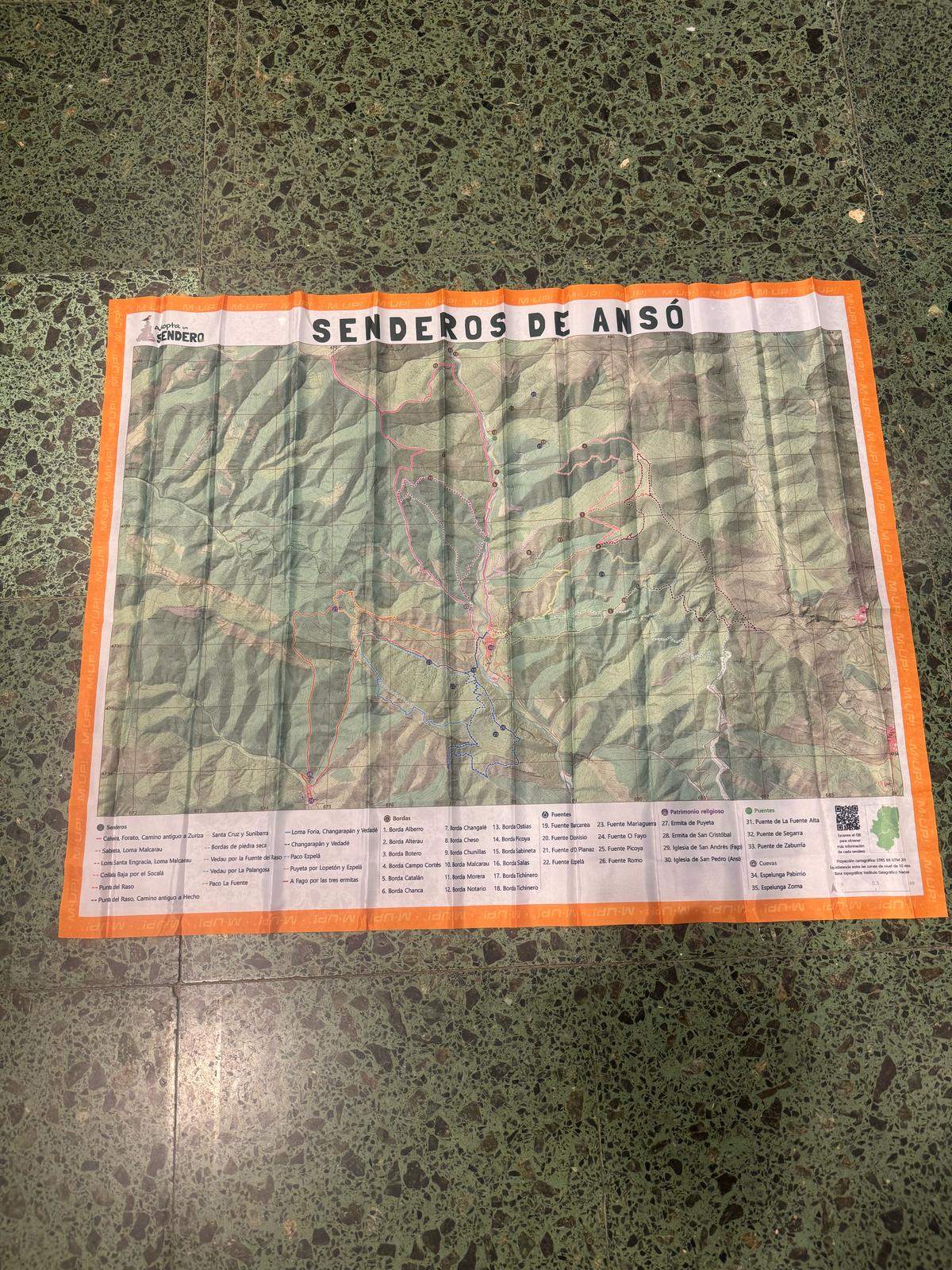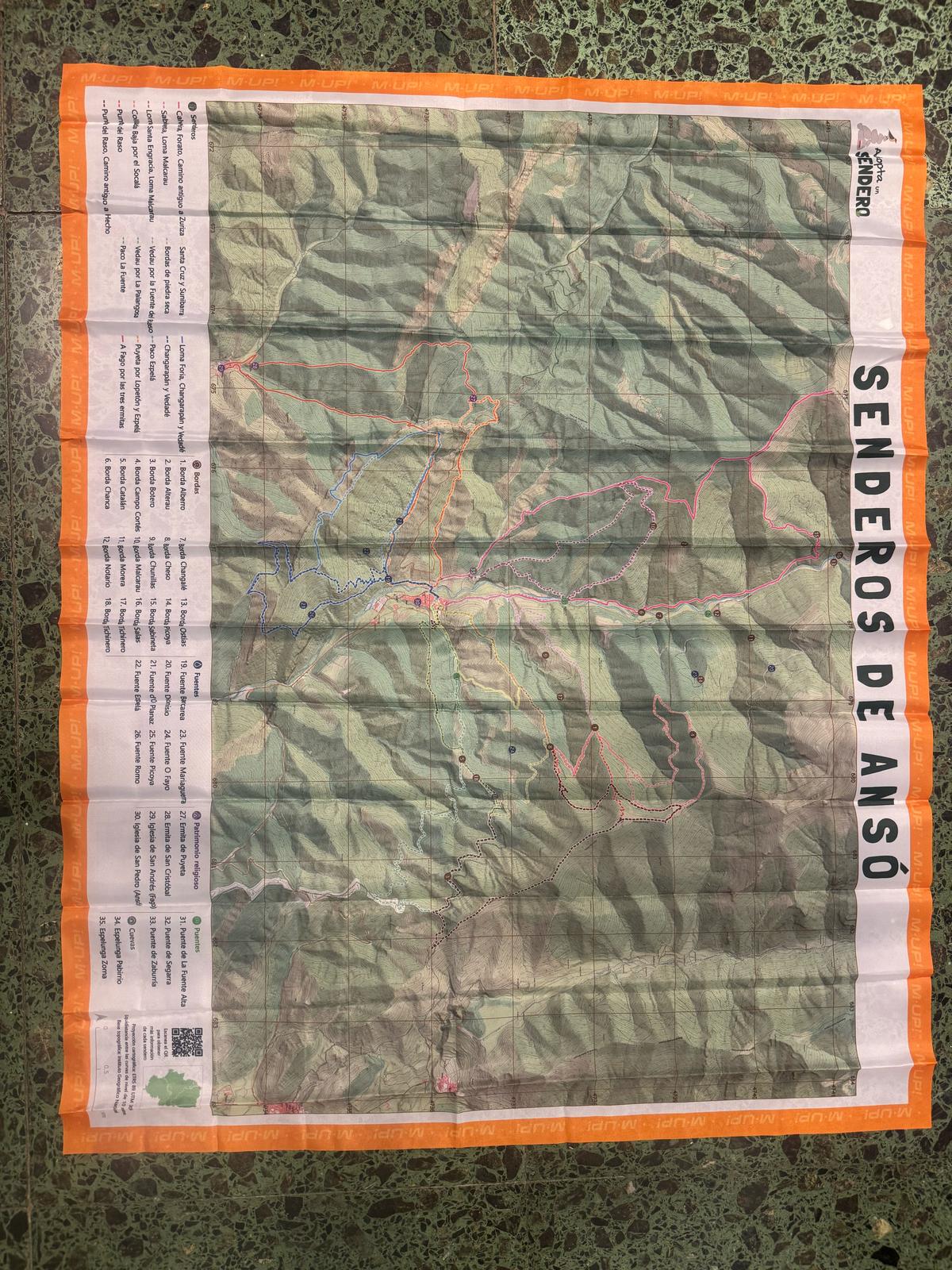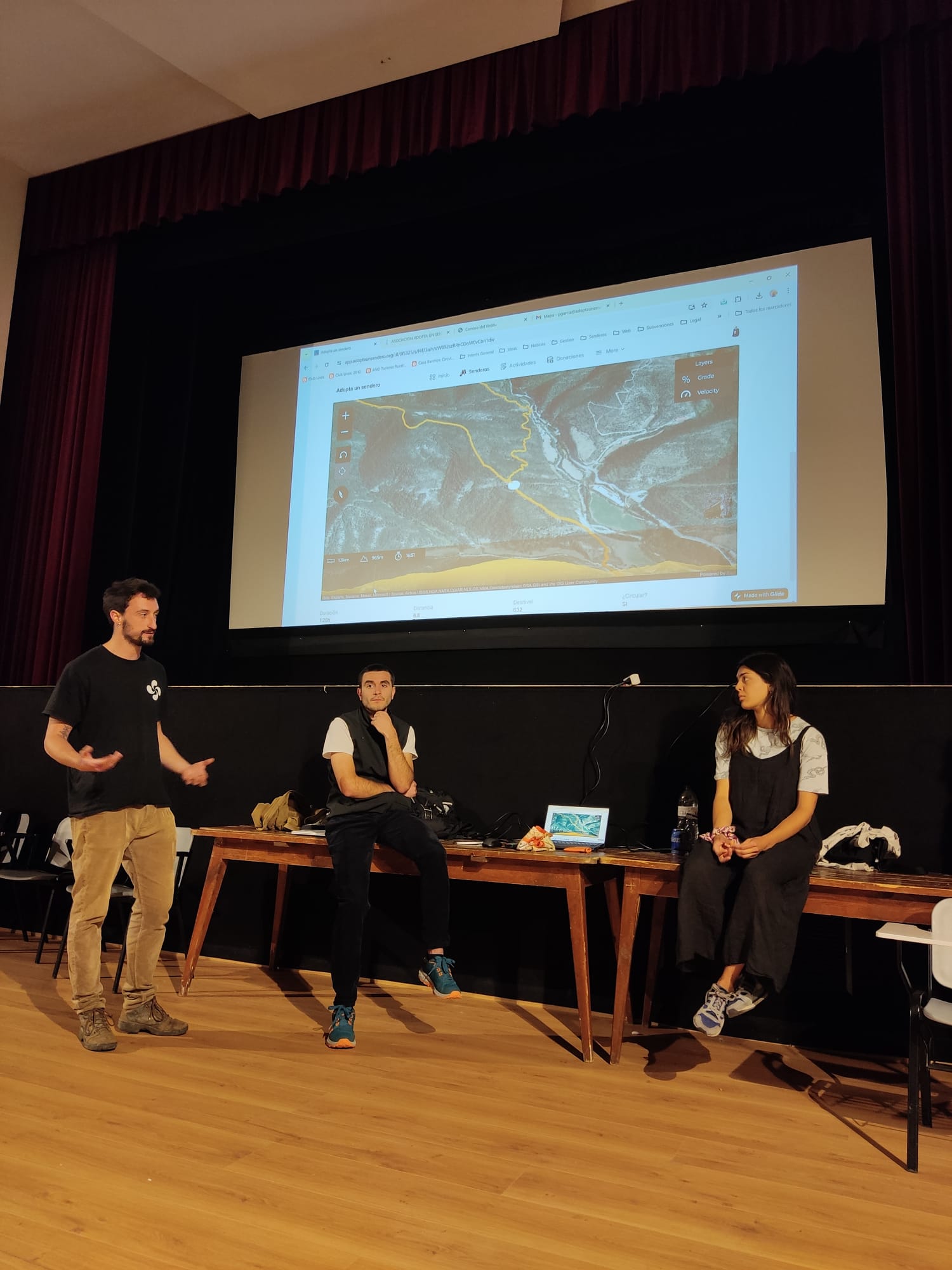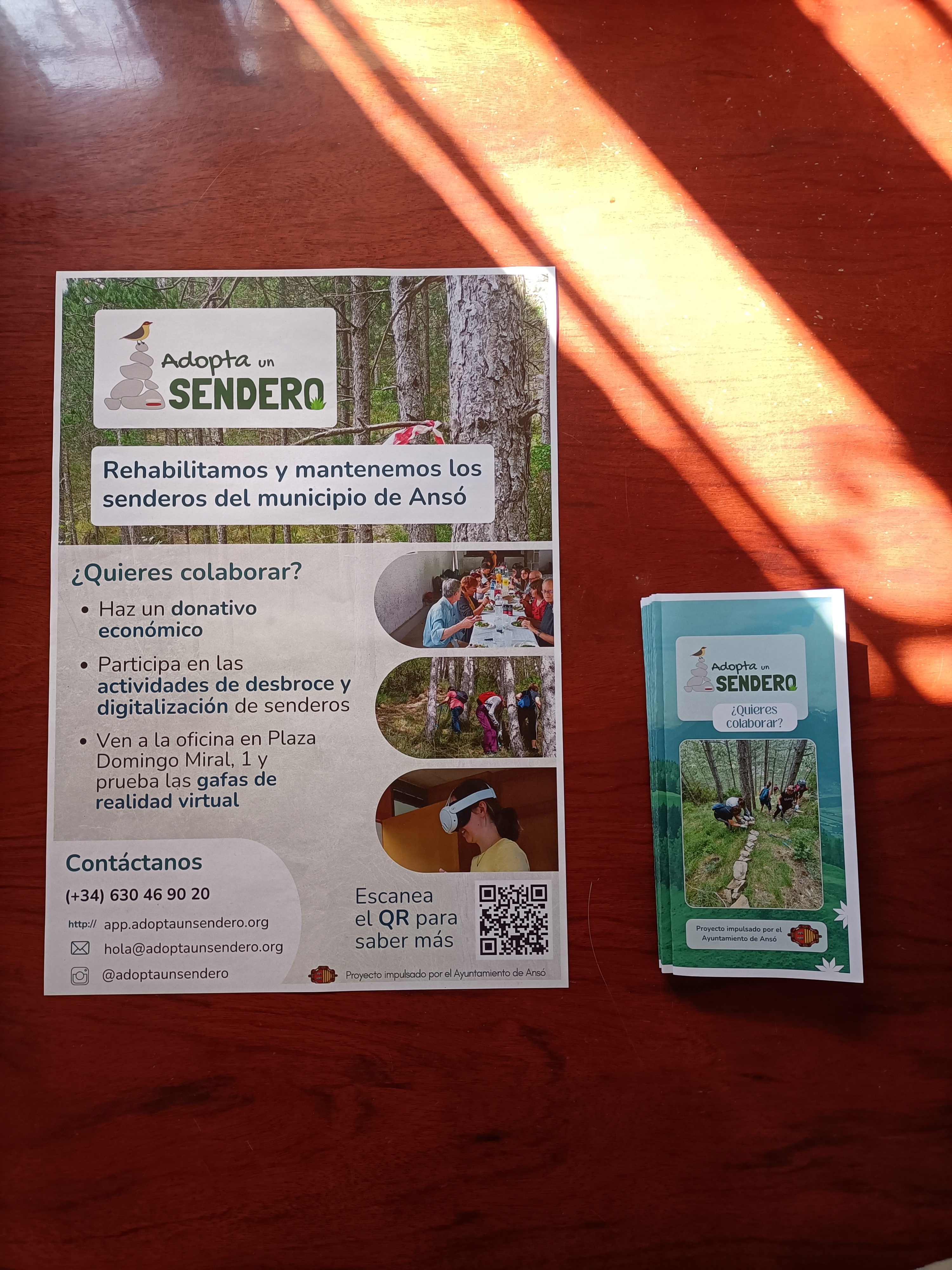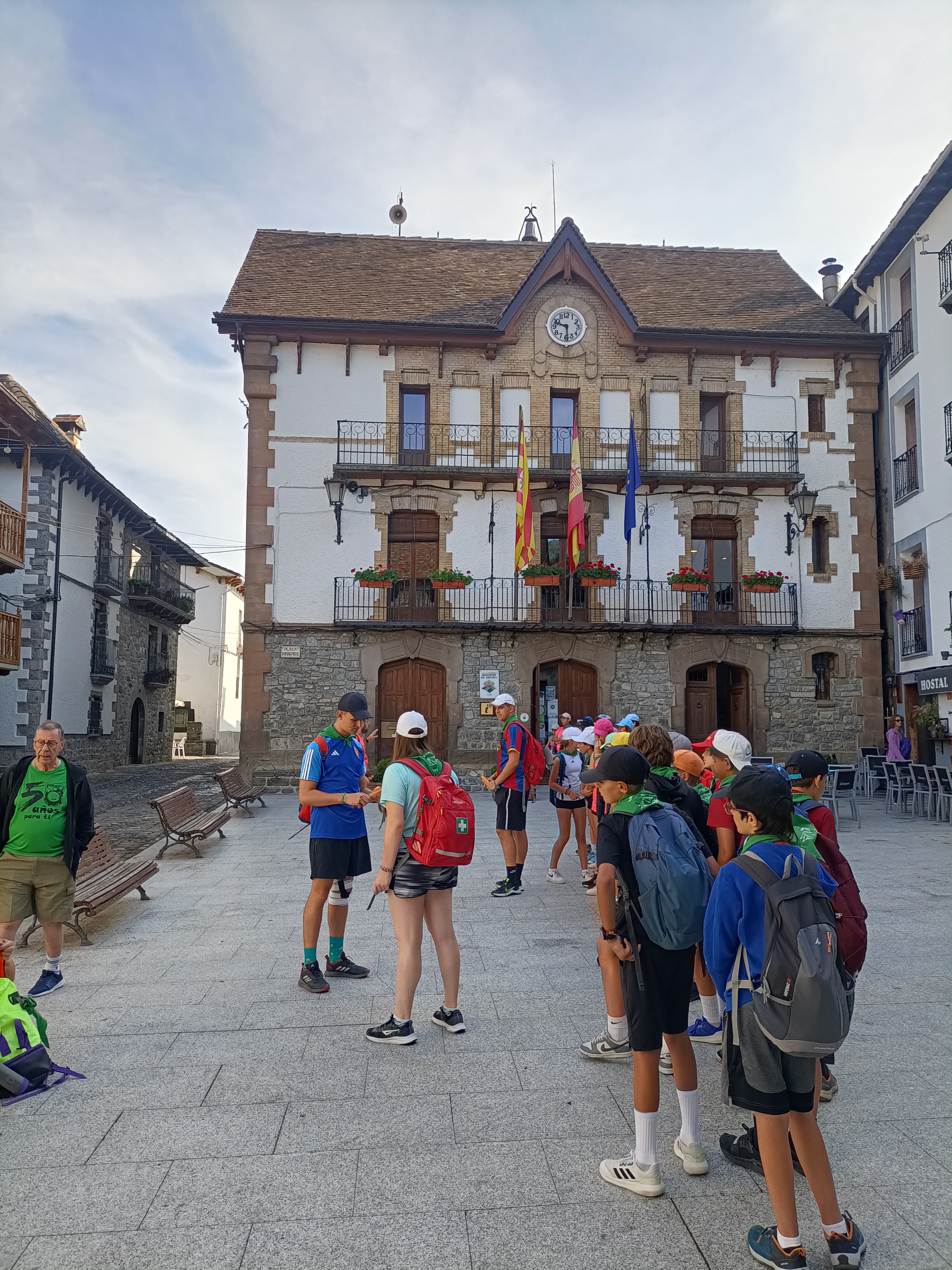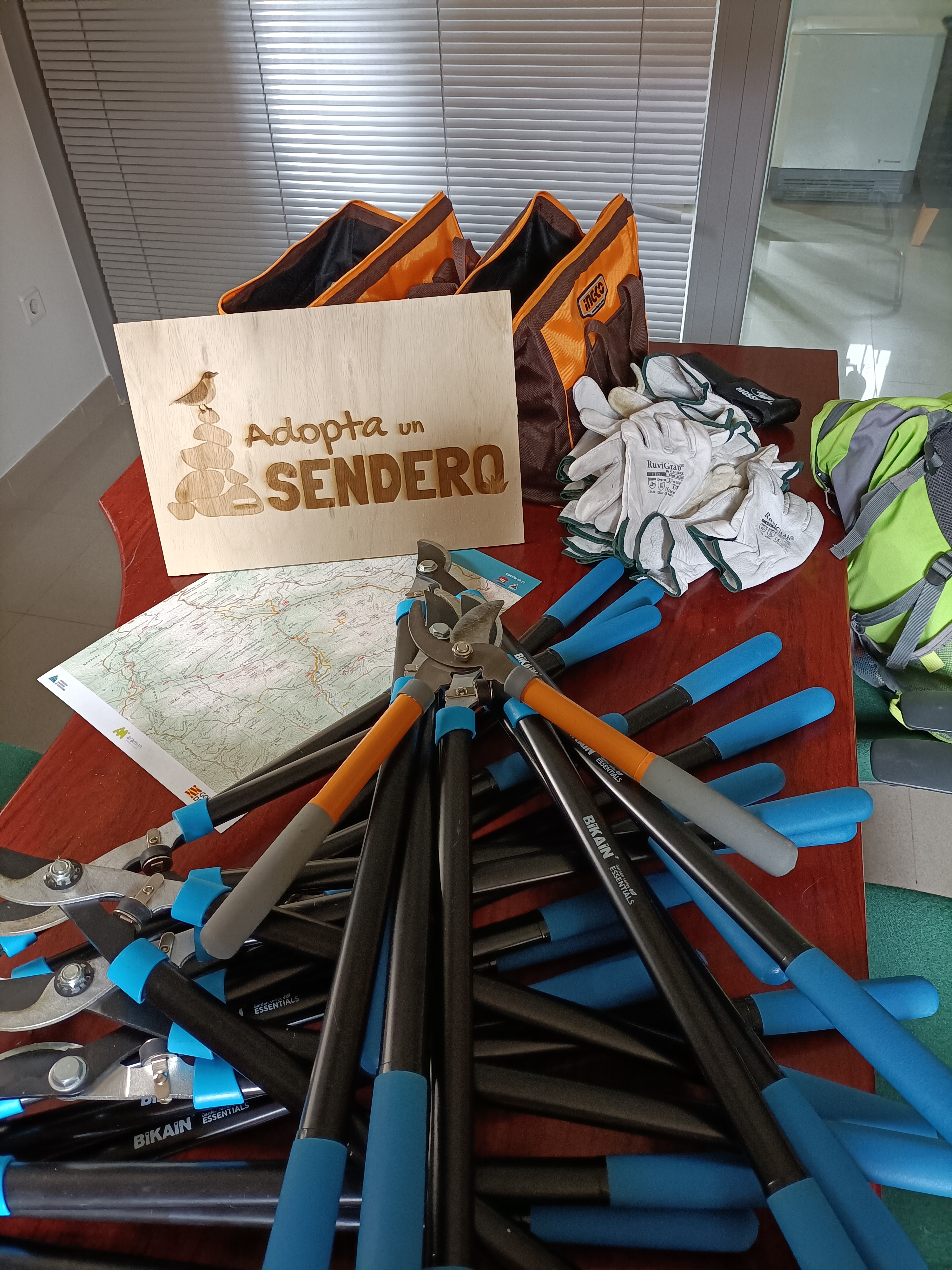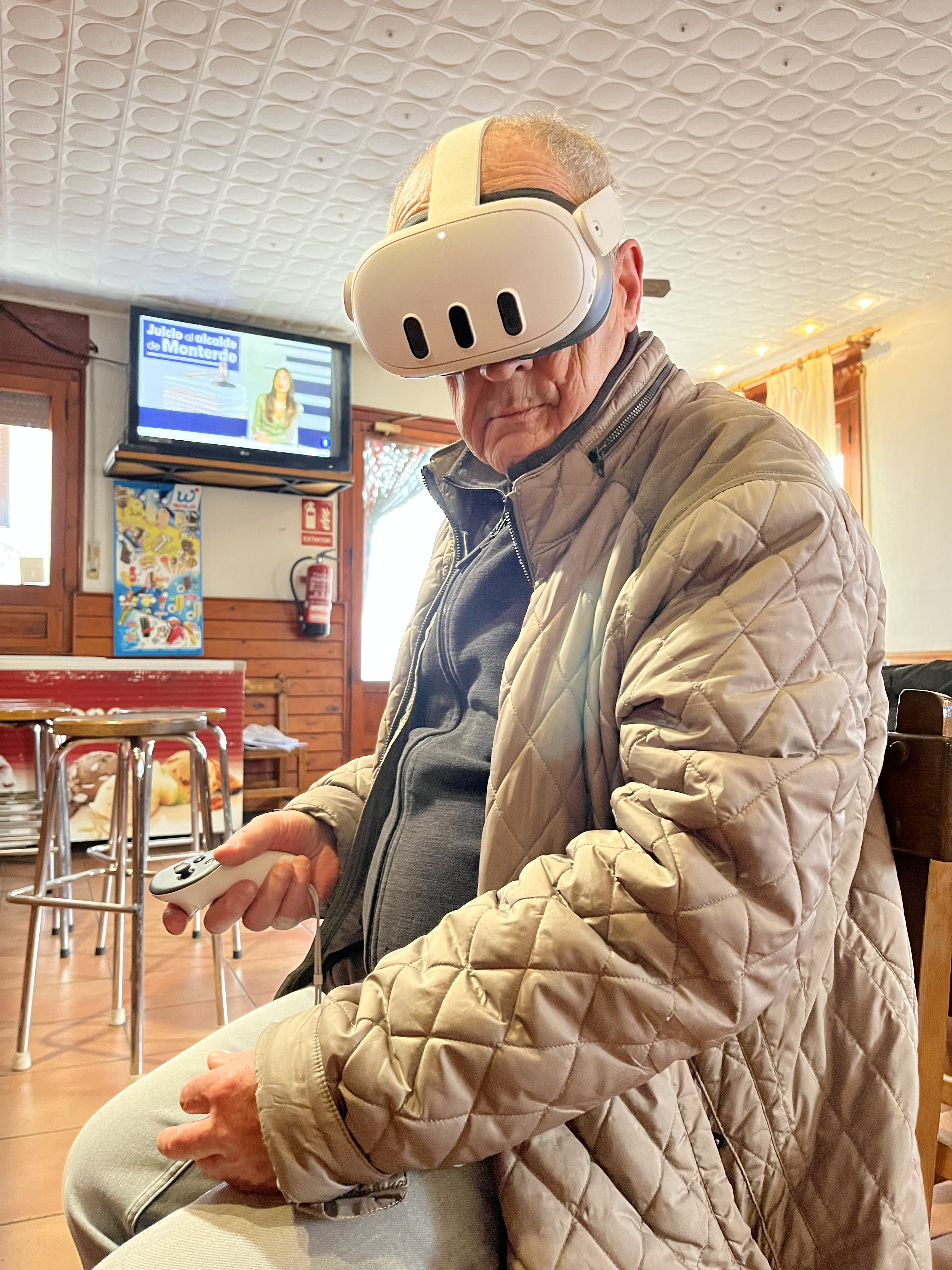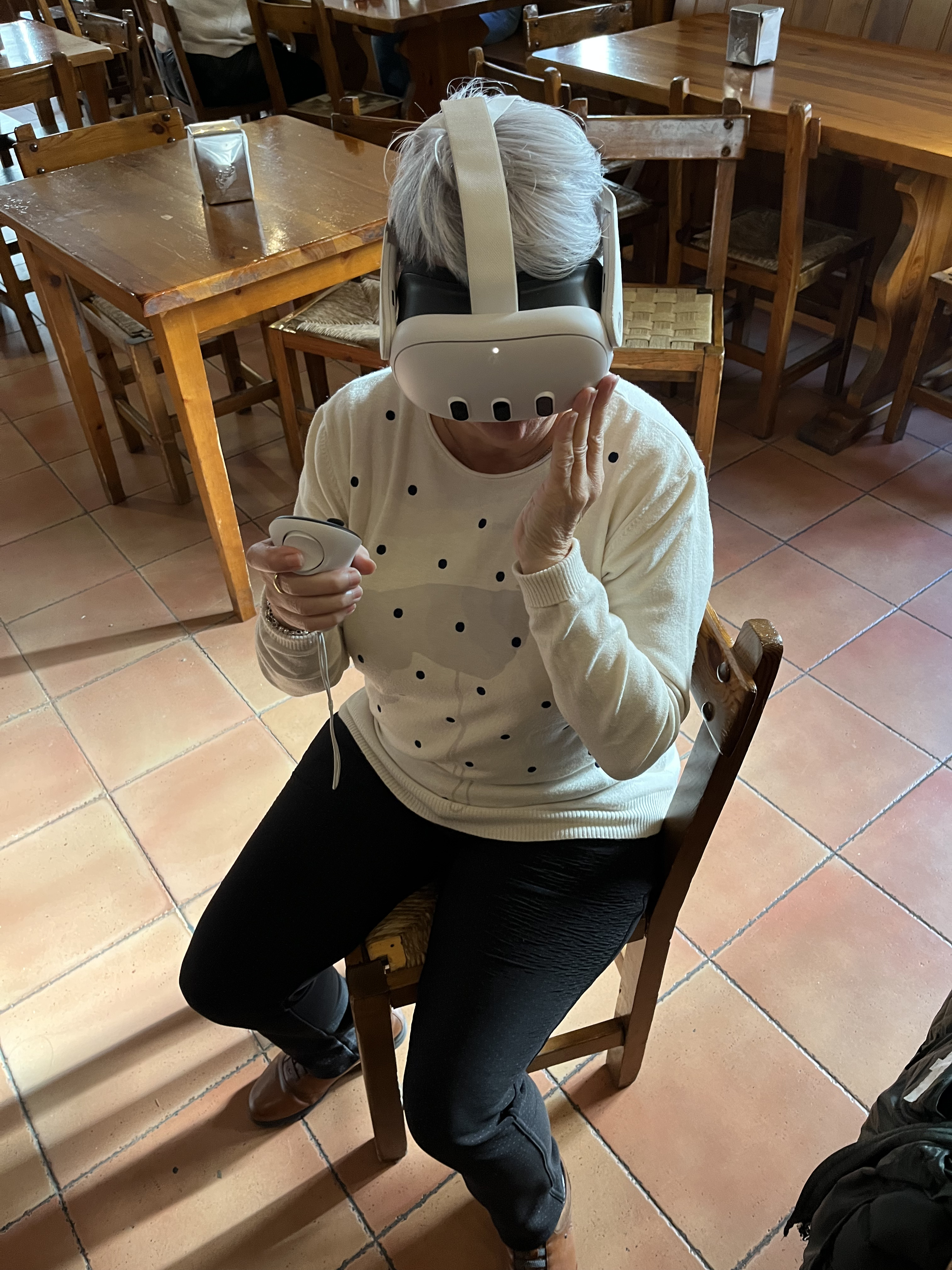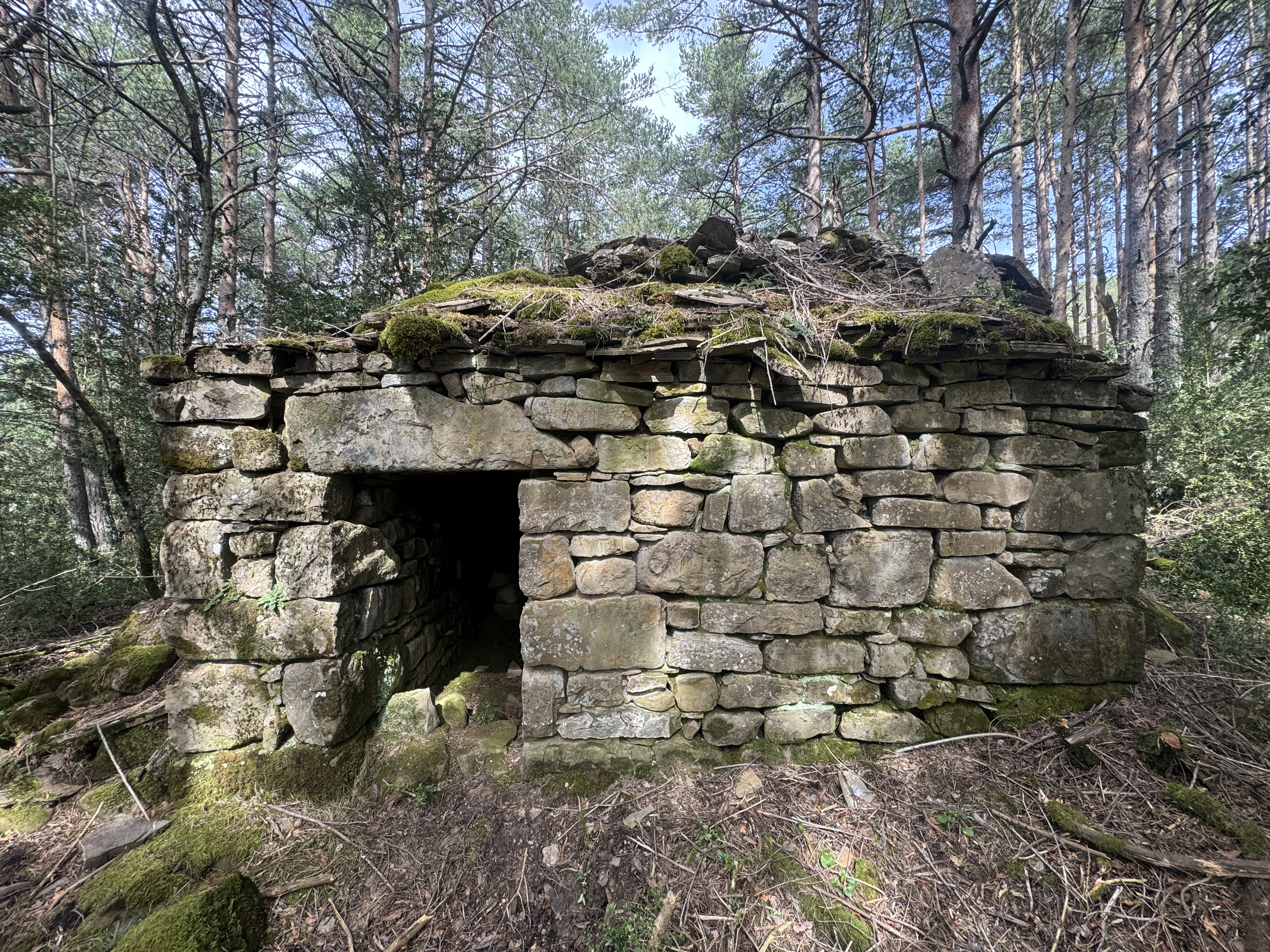Reconnecting with nature
Adopt a Trail: Reviving Nature Paths
Adopt a Trail: Reviving Nature Paths Through Community Engagement and Digital Innovation
"Adopt a Trail: Reviving Nature Paths" restores lost trails that have become inaccessible due to natural overgrowth. Through volunteer clean-ups and community activities, we make these paths walkable again. To enhance accessibility, we offer virtual tours of the trails, allowing anyone to explore them from anywhere in the world. Visitors to the Ansó office can also use VR headsets to preview all eight digitized trails before setting off on their journey.
Spain
Local
Ansó and Fago
Mainly rural
It refers to other types of transformations (soft investment)
Yes
2024-11-15
Yes
Funded by the Spanish Ministry for the Demographic Challenge under the Next Generation EU Programme.
No
No
As a representative of an organisation
"Adopt a Trail: Reviving Nature Paths" restores and maintains historical trails that have become inaccessible due to natural overgrowth. Through volunteer-led clean-ups and educational programs, the project ensures these trails remain open and walkable. To enhance accessibility, virtual tours allow people worldwide to explore the trails remotely, while a VR experience at the visitor center in Ansó lets visitors preview all eight digitized trails before setting out.
The project targets local residents, nature enthusiasts, hikers, and eco-tourists. Schools and educational institutions participate in environmental awareness efforts, while elderly individuals and those with limited mobility can explore the trails virtually.
Its objectives include restoring and maintaining trails, fostering environmental awareness through educational programs and intergenerational volunteering, leveraging digital tools to provide remote access to nature, and promoting sustainable tourism through responsible exploration of natural heritage. The project is funded through annual €50 donations, allowing individuals to adopt 100 meters of a trail, ensuring long-term maintenance and community involvement.
To date, 40 km of trails across 8 of 16 paths have been restored, benefiting over 1000 users. A team of 52 volunteers has participated in clean-up efforts, while more than 300 people have engaged in educational activities. Additionally, 100+ individuals have taken part in intergenerational volunteering, strengthening community ties. The integration of digital innovation has broadened its reach, with 500+ users experiencing the trails through VR.
Supported by local municipalities, rural development associations, and the Spanish Ministry for the Demographic Challenge under Next Generation EU, Adopt a Trail blends community action, conservation, and digital accessibility, ensuring these trails remain a valuable cultural and environmental resource for future generations.
The project targets local residents, nature enthusiasts, hikers, and eco-tourists. Schools and educational institutions participate in environmental awareness efforts, while elderly individuals and those with limited mobility can explore the trails virtually.
Its objectives include restoring and maintaining trails, fostering environmental awareness through educational programs and intergenerational volunteering, leveraging digital tools to provide remote access to nature, and promoting sustainable tourism through responsible exploration of natural heritage. The project is funded through annual €50 donations, allowing individuals to adopt 100 meters of a trail, ensuring long-term maintenance and community involvement.
To date, 40 km of trails across 8 of 16 paths have been restored, benefiting over 1000 users. A team of 52 volunteers has participated in clean-up efforts, while more than 300 people have engaged in educational activities. Additionally, 100+ individuals have taken part in intergenerational volunteering, strengthening community ties. The integration of digital innovation has broadened its reach, with 500+ users experiencing the trails through VR.
Supported by local municipalities, rural development associations, and the Spanish Ministry for the Demographic Challenge under Next Generation EU, Adopt a Trail blends community action, conservation, and digital accessibility, ensuring these trails remain a valuable cultural and environmental resource for future generations.
Nature Restoration
Community Engagement
Sustainable Tourism
Digital Accessibility
Environmental Education
"Adopt a Trail: Reviving Nature Paths" embodies sustainability by restoring and maintaining historical trails that have been overtaken by natural overgrowth. The project prevents further degradation of these paths while fostering responsible land stewardship through community-led clean-ups and conservation efforts. By removing obstacles and ensuring proper maintenance, the initiative guarantees that these trails remain accessible for future generations, minimizing environmental impact while promoting eco-tourism.
The project aligns with circular economy principles by using sustainable materials for trail signage and restoration, avoiding excessive interventions that could disrupt the natural landscape. Additionally, it reduces environmental footprints by encouraging non-motorized mobility, such as hiking and walking, as alternatives to high-impact tourism.
A key element of sustainability is its self-sustaining financial model, where individuals adopt 100 meters of a trail through an annual €50 donation, ensuring long-term maintenance without reliance on temporary funding. This system fosters local engagement and collective responsibility for nature conservation.
Moreover, Adopt a Trail integrates digital accessibility through virtual tours, reducing the need for excessive physical infrastructure and allowing people worldwide to explore the trails remotely. The project's impact extends beyond local communities by promoting environmental education, increasing awareness about conservation, and fostering a long-lasting commitment to nature protection.
By merging active conservation, sustainable tourism, and digital solutions, the project serves as a replicable model for preserving natural landscapes while ensuring their continued enjoyment in an environmentally responsible way.
The project aligns with circular economy principles by using sustainable materials for trail signage and restoration, avoiding excessive interventions that could disrupt the natural landscape. Additionally, it reduces environmental footprints by encouraging non-motorized mobility, such as hiking and walking, as alternatives to high-impact tourism.
A key element of sustainability is its self-sustaining financial model, where individuals adopt 100 meters of a trail through an annual €50 donation, ensuring long-term maintenance without reliance on temporary funding. This system fosters local engagement and collective responsibility for nature conservation.
Moreover, Adopt a Trail integrates digital accessibility through virtual tours, reducing the need for excessive physical infrastructure and allowing people worldwide to explore the trails remotely. The project's impact extends beyond local communities by promoting environmental education, increasing awareness about conservation, and fostering a long-lasting commitment to nature protection.
By merging active conservation, sustainable tourism, and digital solutions, the project serves as a replicable model for preserving natural landscapes while ensuring their continued enjoyment in an environmentally responsible way.
"Adopt a Trail" enhances the aesthetic and cultural experience of nature by preserving and reviving historic paths that offer breathtaking landscapes and a deep connection to local heritage. The project goes beyond simple restoration, ensuring that each trail reflects the natural beauty and identity of the region while making them enjoyable and accessible for all visitors.
The initiative carefully balances human intervention and nature preservation, avoiding excessive artificial modifications. Trail signage and wayfinding elements are designed to blend harmoniously with the landscape, using natural and sustainable materials that respect the surroundings.
One of the most innovative aspects of the project is the virtual reality (VR) experience, which allows visitors to preview all eight digitized trails before physically exploring them. This feature enhances decision-making and anticipation, enabling users to immerse themselves in the natural and cultural aspects of each route before setting foot on the trails.
Through digital storytelling and interpretative elements, Adopt a Trail enriches the experience by highlighting historical, ecological, and cultural aspects of the landscape, fostering a deeper appreciation for its uniqueness. Additionally, by making trails more visually and physically accessible, the project contributes to a more inclusive and enjoyable nature experience, ensuring that visitors can explore the beauty of the region without barriers.
By integrating design, heritage conservation, and immersive technology, Adopt a Trail offers a multisensory and meaningful outdoor experience, positioning itself as a model for sustainable and engaging landscape restoration.
The initiative carefully balances human intervention and nature preservation, avoiding excessive artificial modifications. Trail signage and wayfinding elements are designed to blend harmoniously with the landscape, using natural and sustainable materials that respect the surroundings.
One of the most innovative aspects of the project is the virtual reality (VR) experience, which allows visitors to preview all eight digitized trails before physically exploring them. This feature enhances decision-making and anticipation, enabling users to immerse themselves in the natural and cultural aspects of each route before setting foot on the trails.
Through digital storytelling and interpretative elements, Adopt a Trail enriches the experience by highlighting historical, ecological, and cultural aspects of the landscape, fostering a deeper appreciation for its uniqueness. Additionally, by making trails more visually and physically accessible, the project contributes to a more inclusive and enjoyable nature experience, ensuring that visitors can explore the beauty of the region without barriers.
By integrating design, heritage conservation, and immersive technology, Adopt a Trail offers a multisensory and meaningful outdoor experience, positioning itself as a model for sustainable and engaging landscape restoration.
Inclusivity is at the core of Adopt a Trail, ensuring that nature and cultural heritage are accessible to everyone, regardless of physical ability, age, or location. The project removes barriers by restoring overgrown and inaccessible trails, allowing diverse groups—families, elderly individuals, and people with disabilities—to safely enjoy these outdoor spaces.
A major contribution to inclusivity is the virtual trail experience, which makes these landscapes accessible to those who cannot physically explore them. The VR experience at the visitor center in Ansó allows users to preview all eight digitized trails, helping them choose routes suited to their preferences and abilities. Additionally, virtual tours make it possible for individuals worldwide to explore the trails remotely, expanding the project's reach and impact.
The project actively fosters intergenerational participation, with 100+ people engaged in educational programs and volunteering activities that connect young and older generations. By promoting shared experiences and knowledge exchange, Adopt a Trail strengthens community ties and collective ownership of local natural heritage.
Moreover, the initiative promotes economic inclusivity through a low-cost funding model, where individuals contribute through an annual €50 donation to adopt 100 meters of a trail. This allows for a democratic, community-driven financial structure, ensuring that trail maintenance is not solely dependent on institutional grants.
By removing physical, digital, generational, and economic barriers, Adopt a Trail ensures that the appreciation and preservation of natural heritage are truly accessible to all.
A major contribution to inclusivity is the virtual trail experience, which makes these landscapes accessible to those who cannot physically explore them. The VR experience at the visitor center in Ansó allows users to preview all eight digitized trails, helping them choose routes suited to their preferences and abilities. Additionally, virtual tours make it possible for individuals worldwide to explore the trails remotely, expanding the project's reach and impact.
The project actively fosters intergenerational participation, with 100+ people engaged in educational programs and volunteering activities that connect young and older generations. By promoting shared experiences and knowledge exchange, Adopt a Trail strengthens community ties and collective ownership of local natural heritage.
Moreover, the initiative promotes economic inclusivity through a low-cost funding model, where individuals contribute through an annual €50 donation to adopt 100 meters of a trail. This allows for a democratic, community-driven financial structure, ensuring that trail maintenance is not solely dependent on institutional grants.
By removing physical, digital, generational, and economic barriers, Adopt a Trail ensures that the appreciation and preservation of natural heritage are truly accessible to all.
"Adopt a Trail: Reviving Nature Paths" is a community-driven project where citizens play a central role in both the design and implementation phases. The initiative actively engages local residents, volunteers, and environmental enthusiasts to restore and maintain trails that had become inaccessible due to natural overgrowth. Through clean-up activities, educational workshops, and participatory decision-making, the project fosters a sense of ownership and responsibility for preserving local natural heritage.
More than 52 volunteers have directly contributed to trail restoration, participating in periodic maintenance efforts. Additionally, the project encourages intergenerational engagement, with over 100 individuals from different age groups taking part in educational programs and joint volunteering activities. This exchange strengthens community bonds and ensures that traditional environmental knowledge is passed down to younger generations.
Beyond physical restoration, the project enhances digital accessibility, offering virtual trail tours and a VR experience in Ansó. This component allows citizens who may not be able to physically access the trails—such as elderly individuals or those with mobility challenges—to explore them remotely. This digital inclusion reinforces the project’s commitment to making nature accessible to all.
By involving local communities in every phase, from planning to execution, Adopt a Trail empowers citizens to take an active role in environmental conservation, fostering a long-term commitment to sustainability, cultural heritage, and social cohesion.
More than 52 volunteers have directly contributed to trail restoration, participating in periodic maintenance efforts. Additionally, the project encourages intergenerational engagement, with over 100 individuals from different age groups taking part in educational programs and joint volunteering activities. This exchange strengthens community bonds and ensures that traditional environmental knowledge is passed down to younger generations.
Beyond physical restoration, the project enhances digital accessibility, offering virtual trail tours and a VR experience in Ansó. This component allows citizens who may not be able to physically access the trails—such as elderly individuals or those with mobility challenges—to explore them remotely. This digital inclusion reinforces the project’s commitment to making nature accessible to all.
By involving local communities in every phase, from planning to execution, Adopt a Trail empowers citizens to take an active role in environmental conservation, fostering a long-term commitment to sustainability, cultural heritage, and social cohesion.
The success of Adopt a Trail is built upon the active engagement of stakeholders at multiple levels—local, regional, and national—ensuring a comprehensive and sustainable impact.
At the local level, the project collaborates with the municipality of Ansó, which has provided logistical support and promoted the initiative as part of its eco-tourism strategy. Additionally, local businesses and community groups have engaged in fundraising activities, contributing to the project's economic sustainability through annual €50 donations that allow individuals to adopt sections of a trail.
At the regional level, Adopt a Trail partners with the Association for Rural Technological Development and the Comarca de La Jacetania, aligning with broader efforts to promote sustainable tourism, heritage preservation, and digital innovation. These partnerships help expand the project’s visibility and ensure that best practices are shared across the region.
At the national level, the project has received support from the Spanish Ministry for the Demographic Challenge, benefiting from Next Generation EU funding to scale up its impact and introduce digital innovations such as virtual trail tours and VR experiences. This backing validates the project’s alignment with national sustainability and rural development policies.
By integrating multi-level cooperation, Adopt a Trail demonstrates the power of collaborative governance and cross-sector engagement, ensuring long-term success while serving as a replicable model for similar initiatives across Europe.
At the local level, the project collaborates with the municipality of Ansó, which has provided logistical support and promoted the initiative as part of its eco-tourism strategy. Additionally, local businesses and community groups have engaged in fundraising activities, contributing to the project's economic sustainability through annual €50 donations that allow individuals to adopt sections of a trail.
At the regional level, Adopt a Trail partners with the Association for Rural Technological Development and the Comarca de La Jacetania, aligning with broader efforts to promote sustainable tourism, heritage preservation, and digital innovation. These partnerships help expand the project’s visibility and ensure that best practices are shared across the region.
At the national level, the project has received support from the Spanish Ministry for the Demographic Challenge, benefiting from Next Generation EU funding to scale up its impact and introduce digital innovations such as virtual trail tours and VR experiences. This backing validates the project’s alignment with national sustainability and rural development policies.
By integrating multi-level cooperation, Adopt a Trail demonstrates the power of collaborative governance and cross-sector engagement, ensuring long-term success while serving as a replicable model for similar initiatives across Europe.
Adopt a Trail is a multidisciplinary project that brings together environmental conservation, community engagement, technology, and sustainable tourism, creating a holistic approach to trail restoration and accessibility.
The project involves environmental specialists who guide the restoration process, ensuring that trail maintenance follows sustainable practices that preserve local biodiversity. Additionally, educators and community leaders play a crucial role in organizing workshops and volunteer programs, fostering environmental awareness and intergenerational learning.
One of the most innovative aspects of Adopt a Trail is its integration of digital tools and immersive technology. A team of digital designers and VR specialists has developed virtual tours and a VR-based experience, allowing users to explore trails remotely. This interdisciplinary collaboration ensures that nature and technology complement each other, making the trails accessible to a broader audience, including individuals who may not be able to visit them physically.
Moreover, the project aligns with sustainable tourism experts, ensuring that the restored trails contribute to the local economy by attracting responsible visitors who respect the natural environment. By balancing conservation with tourism, Adopt a Trail enhances the long-term economic viability of rural areas while preserving their ecological integrity.
This cross-disciplinary approach ensures that the project not only restores trails but also redefines how people interact with nature, heritage, and technology, making it a benchmark for innovative and inclusive environmental initiatives.
The project involves environmental specialists who guide the restoration process, ensuring that trail maintenance follows sustainable practices that preserve local biodiversity. Additionally, educators and community leaders play a crucial role in organizing workshops and volunteer programs, fostering environmental awareness and intergenerational learning.
One of the most innovative aspects of Adopt a Trail is its integration of digital tools and immersive technology. A team of digital designers and VR specialists has developed virtual tours and a VR-based experience, allowing users to explore trails remotely. This interdisciplinary collaboration ensures that nature and technology complement each other, making the trails accessible to a broader audience, including individuals who may not be able to visit them physically.
Moreover, the project aligns with sustainable tourism experts, ensuring that the restored trails contribute to the local economy by attracting responsible visitors who respect the natural environment. By balancing conservation with tourism, Adopt a Trail enhances the long-term economic viability of rural areas while preserving their ecological integrity.
This cross-disciplinary approach ensures that the project not only restores trails but also redefines how people interact with nature, heritage, and technology, making it a benchmark for innovative and inclusive environmental initiatives.
"Adopt a Trail: Reviving Nature Paths" stands out from conventional trail restoration projects by combining community engagement, digital accessibility, and a self-sustaining financial model to ensure long-term impact. While mainstream restoration efforts typically focus on physical clean-up and maintenance, Adopt a Trail introduces immersive technology (VR) and participatory funding mechanisms, setting a new benchmark for environmental and cultural preservation.
Unlike traditional projects, where funding relies solely on public grants or government budgets, Adopt a Trail implements an innovative donation system, allowing individuals to adopt 100 meters of a trail for an annual €50 contribution. This approach fosters community ownership, ensuring continuous maintenance beyond initial funding periods.
Another major innovation is the integration of virtual reality (VR) into trail exploration. Many nature restoration projects emphasize physical restoration without considering digital inclusion. Adopt a Trail provides virtual tours, allowing users worldwide to explore the trails remotely. Additionally, visitors to the Ansó visitor center can use VR headsets to preview all eight digitized trails before choosing their route. This solution enhances accessibility, particularly for elderly individuals or those with mobility challenges, making nature experiences available to a wider audience.
By merging physical restoration, digital accessibility, and community-driven funding, Adopt a Trail serves as a scalable model that can be replicated across Europe, redefining how people engage with nature in an inclusive and innovative way.
Unlike traditional projects, where funding relies solely on public grants or government budgets, Adopt a Trail implements an innovative donation system, allowing individuals to adopt 100 meters of a trail for an annual €50 contribution. This approach fosters community ownership, ensuring continuous maintenance beyond initial funding periods.
Another major innovation is the integration of virtual reality (VR) into trail exploration. Many nature restoration projects emphasize physical restoration without considering digital inclusion. Adopt a Trail provides virtual tours, allowing users worldwide to explore the trails remotely. Additionally, visitors to the Ansó visitor center can use VR headsets to preview all eight digitized trails before choosing their route. This solution enhances accessibility, particularly for elderly individuals or those with mobility challenges, making nature experiences available to a wider audience.
By merging physical restoration, digital accessibility, and community-driven funding, Adopt a Trail serves as a scalable model that can be replicated across Europe, redefining how people engage with nature in an inclusive and innovative way.
The methodology of Adopt a Trail is based on a three-pillar approach: community participation, digital innovation, and financial sustainability, ensuring the long-term success of trail restoration efforts.
1- Community-Driven Restoration:
The project actively involves local volunteers in trail maintenance and clean-up activities. Through community workshops and environmental education programs, it fosters a shared responsibility for nature conservation. To date, 52 volunteers have participated in clean-up efforts, while over 100 individuals have engaged in intergenerational learning programs, strengthening community bonds.
2- Digital Accessibility and VR Integration:
Unlike traditional restoration efforts that focus solely on physical trails, Adopt a Trail embraces immersive technology to enhance user experience. Virtual trail tours allow users worldwide to explore routes before visiting, while VR headsets at the Ansó visitor center enable visitors to preview all eight digitized trails. This not only improves accessibility for people with mobility restrictions but also promotes digital inclusion in nature-based tourism.
3- Self-Sustaining Economic Model:
Instead of depending entirely on external grants, the project implements a community-driven funding model, where individuals adopt 100 meters of a trail for €50 per year. This approach ensures continuous funding for trail maintenance and fosters long-term community engagement.
By combining on-the-ground conservation, innovative technology, and a participatory financial model, Adopt a Trail introduces a scalable and replicable approach to sustainable trail restoration, setting a new standard in the field.
1- Community-Driven Restoration:
The project actively involves local volunteers in trail maintenance and clean-up activities. Through community workshops and environmental education programs, it fosters a shared responsibility for nature conservation. To date, 52 volunteers have participated in clean-up efforts, while over 100 individuals have engaged in intergenerational learning programs, strengthening community bonds.
2- Digital Accessibility and VR Integration:
Unlike traditional restoration efforts that focus solely on physical trails, Adopt a Trail embraces immersive technology to enhance user experience. Virtual trail tours allow users worldwide to explore routes before visiting, while VR headsets at the Ansó visitor center enable visitors to preview all eight digitized trails. This not only improves accessibility for people with mobility restrictions but also promotes digital inclusion in nature-based tourism.
3- Self-Sustaining Economic Model:
Instead of depending entirely on external grants, the project implements a community-driven funding model, where individuals adopt 100 meters of a trail for €50 per year. This approach ensures continuous funding for trail maintenance and fosters long-term community engagement.
By combining on-the-ground conservation, innovative technology, and a participatory financial model, Adopt a Trail introduces a scalable and replicable approach to sustainable trail restoration, setting a new standard in the field.
"Adopt a Trail" presents a scalable and adaptable model that can be replicated in other regions facing similar challenges related to trail degradation, accessibility, and community engagement. Its success is based on three key transferable elements:
1- Community-Driven Restoration Model – The project’s methodology of engaging local volunteers and organizations in the clean-up and maintenance of nature trails can be easily replicated in different geographical areas. The structured approach of intergenerational volunteering, environmental education, and collective ownership ensures long-term sustainability and can be applied in both rural and urban contexts.
2- Digital Accessibility and VR Integration – The use of virtual tours and VR experiences to make trails accessible to a wider audience, including people with mobility limitations, is an innovative approach that can be adopted by other nature conservation projects. This technology can be used to digitally map trails in different locations, allowing for virtual exploration and preservation beyond physical visits.
3- Self-Sustaining Economic Model – The €50 annual donation system, where individuals "adopt" 100 meters of a trail, provides a replicable alternative funding mechanism that reduces reliance on external grants. This financial model ensures long-term maintenance and encourages local community investment in nature conservation. Other initiatives can implement a similar model to fund maintenance of public spaces, cultural sites, or environmental projects.
The project can be transferred to any region with natural trails facing accessibility or maintenance issues, especially in areas promoting sustainable tourism, community engagement, and heritage preservation. By combining hands-on restoration, digital innovation, and participatory funding, Adopt a Trail offers a replicable, scalable, and impactful solution to environmental conservation worldwide.
1- Community-Driven Restoration Model – The project’s methodology of engaging local volunteers and organizations in the clean-up and maintenance of nature trails can be easily replicated in different geographical areas. The structured approach of intergenerational volunteering, environmental education, and collective ownership ensures long-term sustainability and can be applied in both rural and urban contexts.
2- Digital Accessibility and VR Integration – The use of virtual tours and VR experiences to make trails accessible to a wider audience, including people with mobility limitations, is an innovative approach that can be adopted by other nature conservation projects. This technology can be used to digitally map trails in different locations, allowing for virtual exploration and preservation beyond physical visits.
3- Self-Sustaining Economic Model – The €50 annual donation system, where individuals "adopt" 100 meters of a trail, provides a replicable alternative funding mechanism that reduces reliance on external grants. This financial model ensures long-term maintenance and encourages local community investment in nature conservation. Other initiatives can implement a similar model to fund maintenance of public spaces, cultural sites, or environmental projects.
The project can be transferred to any region with natural trails facing accessibility or maintenance issues, especially in areas promoting sustainable tourism, community engagement, and heritage preservation. By combining hands-on restoration, digital innovation, and participatory funding, Adopt a Trail offers a replicable, scalable, and impactful solution to environmental conservation worldwide.
"Adopt a Trail" provides local solutions to several pressing global challenges, particularly in the areas of environmental conservation, sustainable tourism, and digital inclusion.
Climate Change and Environmental Degradation – The abandonment of nature trails leads to loss of accessibility, increased environmental degradation, and accumulation of waste. By restoring trails through community engagement, Adopt a Trail actively reduces human impact, promotes reforestation and responsible tourism, and encourages local conservation efforts. This contributes to global goals related to biodiversity protection and land restoration.
Social Cohesion and Rural Depopulation – Many rural areas struggle with depopulation and loss of cultural heritage. By involving local communities, schools, and volunteers, Adopt a Trail fosters a sense of belonging, strengthens intergenerational ties, and promotes rural tourism as a tool for sustainable development. This supports broader efforts to revitalize underpopulated regions across Europe.
Accessibility and Digital Inclusion – Many people with physical disabilities or mobility limitations cannot access nature trails. Adopt a Trail addresses this challenge by integrating virtual experiences and VR technology, allowing remote exploration of trails, making nature accessible to all, regardless of physical limitations or geographic distance. This aligns with EU priorities on digital inclusion and accessibility.
Financial Sustainability and Alternative Funding Models – Most environmental restoration projects depend on short-term grants. Adopt a Trail introduces a community-driven economic model, where individuals and organizations finance conservation through annual donations, ensuring long-term financial sustainability. This approach can be replicated globally to support conservation efforts in a financially independent way.
Climate Change and Environmental Degradation – The abandonment of nature trails leads to loss of accessibility, increased environmental degradation, and accumulation of waste. By restoring trails through community engagement, Adopt a Trail actively reduces human impact, promotes reforestation and responsible tourism, and encourages local conservation efforts. This contributes to global goals related to biodiversity protection and land restoration.
Social Cohesion and Rural Depopulation – Many rural areas struggle with depopulation and loss of cultural heritage. By involving local communities, schools, and volunteers, Adopt a Trail fosters a sense of belonging, strengthens intergenerational ties, and promotes rural tourism as a tool for sustainable development. This supports broader efforts to revitalize underpopulated regions across Europe.
Accessibility and Digital Inclusion – Many people with physical disabilities or mobility limitations cannot access nature trails. Adopt a Trail addresses this challenge by integrating virtual experiences and VR technology, allowing remote exploration of trails, making nature accessible to all, regardless of physical limitations or geographic distance. This aligns with EU priorities on digital inclusion and accessibility.
Financial Sustainability and Alternative Funding Models – Most environmental restoration projects depend on short-term grants. Adopt a Trail introduces a community-driven economic model, where individuals and organizations finance conservation through annual donations, ensuring long-term financial sustainability. This approach can be replicated globally to support conservation efforts in a financially independent way.
"Adopt a Trail: Reviving Nature Paths" has generated measurable environmental, social, and digital accessibility benefits, directly contributing to the Reconnecting with Nature category. Through trail restoration, community engagement, and digital tools, the project has significantly improved access to nature while fostering sustainability and inclusion.
Environmental Impact:
- 40 km of trails restored (8 out of 16 existing trails), making them accessible again.
- Complete removal of waste and debris along restored trails, improving biodiversity and preserving the landscape.
- Promotion of sustainable tourism, reducing environmental pressure on urbanized areas and encouraging responsible outdoor recreation.
Community and Social Impact:
- 52 volunteers actively involved in trail maintenance and conservation activities.
- More than 300 people have participated in environmental education workshops and activities.
- Over 100 individuals engaged in intergenerational volunteering, strengthening social ties and knowledge exchange.
- Strengthened community ownership through participatory restoration efforts, fostering a long-term commitment to conservation.
Digital and Accessibility Impact:
- More than 500 users have explored the trails through virtual reality (VR), increasing accessibility.
- Virtual tours allow people with limited mobility to experience nature remotely.
- A VR station in the Ansó visitor center enables visitors to preview all eight digitized trails, improving decision-making before their journey.
Economic Sustainability Impact:
- The project is financially self-sustaining through an annual €50 donation model, where individuals adopt 100 meters of a trail to support long-term maintenance.
- Increased eco-tourism and local business engagement, contributing to rural economic development.
Environmental Impact:
- 40 km of trails restored (8 out of 16 existing trails), making them accessible again.
- Complete removal of waste and debris along restored trails, improving biodiversity and preserving the landscape.
- Promotion of sustainable tourism, reducing environmental pressure on urbanized areas and encouraging responsible outdoor recreation.
Community and Social Impact:
- 52 volunteers actively involved in trail maintenance and conservation activities.
- More than 300 people have participated in environmental education workshops and activities.
- Over 100 individuals engaged in intergenerational volunteering, strengthening social ties and knowledge exchange.
- Strengthened community ownership through participatory restoration efforts, fostering a long-term commitment to conservation.
Digital and Accessibility Impact:
- More than 500 users have explored the trails through virtual reality (VR), increasing accessibility.
- Virtual tours allow people with limited mobility to experience nature remotely.
- A VR station in the Ansó visitor center enables visitors to preview all eight digitized trails, improving decision-making before their journey.
Economic Sustainability Impact:
- The project is financially self-sustaining through an annual €50 donation model, where individuals adopt 100 meters of a trail to support long-term maintenance.
- Increased eco-tourism and local business engagement, contributing to rural economic development.

